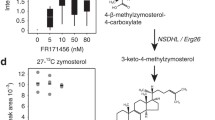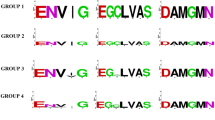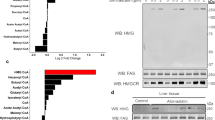Abstract
The enzyme, 3-hydroxy-3-methylglutaryl coenzyme A reductase (HMGR) controls the biosynthesis of cholesterol. Hypercholesterolemia and atherosclerosis are critical health risk factors. One way of controlling these risk factors is to manipulate regulation as well as degradation of HMGR. At present, a class of compounds called statins, which are HMGR inhibitors, are used for the treatment of hypercholesterolemia. However, statins suffer major setbacks as their use produces more adverse reactions than the desirable one of inhibiting the enzyme. Genetically engineered forms of HMGR are also studied in primitive life forms like bacteria, but detailed investigation of this enzyme in human systems is certainly required. Extensive studies have been made on the regulatory aspects of this enzyme, but no breakthrough is conspicuous in the clinical background to find an alternative treatment for hypercholesterolemia. The immediate need is to find an alternate way of regulating degradation of the enzyme. This review presents the importance of regulation and degradation of the HMGR enzyme in different systems to gain possible insight into alternative schemes for regulating this enzyme and, if these exist, the feasibility of extending them same to studies in mammalian systems. A high degree of similarity exists between mammalian and yeast HMGR. Detailed studies reported on the regulation and degradation of the yeast enzyme also throw more light on the mammalian system, leading to a better understanding of ways of controlling hypercholesterolemia.


Similar content being viewed by others
References
Basson ME, Thorsness M, Finer-Moore J, Stroud RM, Rine J (1988) Structural and functional conservation between yeast and human 3-hydroxy-3-methylglutaryl coenzyme A reductases, the rate limiting enzyme of sterol biosynthesis. Mol Cell Biol 8:3797–3808
Beach MJ, Rodwell VW (1989) Cloning, sequencing and overexpression of mvaA, which encodes Pseudomonas mevalonii 3-hydroxy-3-methylglutaryl coenzyme A reductase. J Bacteriol 171:2994–3001
Beg ZH, Stonik JA, Brewer HB (1984) In vivo modulation of rat liver 3-hydroxy-3-methylglutaryl-coenzyme A reductase, reductase kinase, and reductase kinase kinase by mevalonolactone. Proc Natl Acad Sci USA 81:7293–7297
Bischoff KM, Rodwell VW (1997) 3-Hydroxy-3-methylglutaryl-CoA reductase from Haloferax volcanii. Protein Sci 6:156–161
Bliznakov EG (2002) Diabetes and the role of isoprenoid biosynthesis. FEBS Lett 525:169–170
Bochar DA, Stauffacher CV, Rodwell VW (1999) Sequence comparisons reveal two classes of HMG-CoA reductase. Mol Genet Metab 66:122–127
Bradfute DL, Simoni RD (1994) Non-sterol compounds that regulate cholesterogenesis. J Biol Chem 269:6645–6650
Brown MS, Golstein JL (1974) Suppression of 3-hydroxy-3-methylglutaryl coenzyme A reductase activity and inhibition of growth of human fibroblasts by 7-ketocholesterol. J Biol Chem 249:7306–7314
Brown MS, Goldstein JL (1980) Multivalent feedback regulation of HMG CoA reductase, a control mechanism coordinating isoprenoid synthesis and cell growth. J Lipid Res 21:505–517
Brown MS, Dans SE, Goldstein JL (1974) Regulation of 3-hydroxy-3-methylglutaryl coenzyme A reductase activity in cultured human fibroblasts. J Biol Chem 249:789–796
Cappel RE, Gilbert HF (1993) Oxidative inactivation of 3-hydroxy-3-methylglutaryl-coenzyme A reductase and subunit cross-linking involve different dithiol/disulfide centers. J Biol Chem 268:342–348
Carson DD, Lennarz WJ (1979) Inhibition of polyisoprenoid and glycoprotein biosynthesis causes abnormal embryonic development. Proc Natl Acad Sci USA 76:5709–5713
Casey WM, Keesler GA, Parks LW (1992) Regulation of partitioned sterol biosynthesis in Saccharomyces cerevisiae. J Bacteriol 174:7283–7288
Chappell J, Wolf F, Proulx J, Cuellar R, Saunders C (1995) Is the reaction catalyzed by 3-hydroxy-3-methylglutaryl coenzyme A reductase a rate-limiting step for isoprenoid biosynthesis in plants? Plant Physiol 109:1337–1343
Chin DJ, Gil G, Russell DW, Liscum L, Luskey KL, Basu SK, Okayama H, Berg P, Goldstein JL, Brown MS (1984) Nucleotide sequence of 3-hydroxy-3-methylglutaryl coenzyme A reductase, a glycoprotein of the endoplasmic reticulum. Nature 308:613–617
Chin DJ, Gil G, Faust JR, Goldstein JL, Brown MS, Luskey KL (1985) Sterols accelerate degradation of hamster 3-hydroxy-3-methylglutaryl coenzyme A reductase encoded by a constitutively expressed cDNA. Mol Cell Biol 5:634–641
Chun KT, Simoni RD (1992) The role of the membrane domain in the regulated degradation of 3-hydroxy-3-methylglutaryl coenzyme A reductase. J Biol Chem 267:4236–4246
Chun KT, Bar-nun S, Simoni RD (1990) The regulated degradation of 3-hydroxy-3-methylglutaryl-CoA reductase requires a short-lived protein and occurs in the endoplasmic reticulum. J Biol Chem 265:22004–22010
Chye ML, Tan CT, Chua NH (1992) Three genes encode 3-hydroxy-3-methylglutaryl-coenzyme A reductase in Hevea brasiliensis: hmg1 and hmg3 are differentially expressed. Plant Mol Biol 19:473–484
Correll CC, Edwards PA (1994) Mevalonic acid-dependant degradation of HMGR in vivo and in vitro. J Biol Chem 269:633–638
Correll CC, Ng L, Edwards PA (1994) Identification of farnesol as the non-sterol derivative of mevalonic acid required for the accelerated degradation of 3-hydroxy-3-methylglutaryl-coenzyme A reductase. J Biol Chem 269:17390–17393
Corton JM, Gillespie JG, Hardie DG (1994) Role of the AMP-activated protein kinase in the cellular stress response. Curr Biol 4:315–324
Croteau R, Lange MB, Rujan T, Martin W (2000) Isoprenoid biosynthesis: the evolution of two ancient and distinct pathways across genomes. Proc Natl Acad Sci USA 97:13172–13177
Dawson PA, Metherall JE, Ridgway ND, Brown MS, Goldstein JL (1991) Genetic distinction between sterol-mediated transcriptional and posttranscriptional control of 3-hydroxy-3-methylglutaryl-coenzyme A reductase. J Biol Chem 266:9128–9134
Edwards PA, Gould RG (1974) Dependence of the circadian rhythm of hepatic β-hydroxy-β-methylglutaryl coenzyme A on ribonucleic acid synthesis. J Biol Chem 249:2891–2896
Edwards PA, Pepjak G, Fogelman AM, Edmond J (1977) Control of 3-hydroxy-3-methylglutaryl coenzyme A reductase by endogenously synthesized sterols in vitro and in vivo. J Biol Chem 252:1057–1063
Edwards PA, Lan SF, Tanaka RD, Fogelman AM (1983) Mevalonolactone inhibits the rate of synthesis and enhances the rate of degradation of HMGR in rat hepatocytes. J Biol Chem 258:7272–7275
Endo A, Kuroda M, Tanzawa K (1976) Competitive inhibition of 3-hydroxy-3-methylglutaryl coenzyme A reductase by ML-236A and ML-236B fungal metabolites, having hypocholesterolemic activity. FEBS Lett 72:323–326
Enjuto M, Balcells L, Campos N, Caelles C, Arro M, Boronat A (1994) Arabidopsis thaliana contains two differentially expressed 3-hydroxy-3-methylglutaryl-CoA reductase genes, which encode microsomal forms of the enzyme. Proc Natl Acad Sci USA 91:927–931
Faust JR, Luskey KL, Chin DJ, Goldstein JL, Brown MS (1982) Regulation of synthesis and degradation of 3-hydroxy-3-methylglutaryl-coenzyme A reductase by low density lipoprotein and 25-hydroxycholesterol in UT-1 cells. Proc Natl Acad Sci USA 79:5205–5209
Friesen JA, Rodwell VW (1997) Protein engineering of the HMG-CoA reductase of Pseudomonas mevalonii. Construction of mutant enzymes whose activity is regulated by phosphorylation and dephosphorylation. Biochemistry 36:2173–2177
Frimpong KF, Rodwell VW (1994) Catalysis by Syrian hamster 3-hydroxy-3-methylglutaryl-coenzyme A reductase. Proposed roles of histidine 865, glutamate 558, and aspartate 766. J Biol Chem 269:11478–11483
Gardner R, Hampton R (1999) A highly conserved signal controls degradation of 3-hydroxy-3-methylglutaryl-coenzyme A (HMG-CoA) reductase in eukaryotes. J Biol Chem 274:31671–31678
Gardner R, Cronin S, Leder B, Rine J, Hampton R (1998) Sequence determinants for regulated degradation of yeast HMGR, an integral endoplasmic reticulum membrane protein. Mol Biol Cell 9:2611–2626
Gardner R, Shan HS, Matsuda P, Hampton RY (2001) An oxysterol-derived positive signal for HMGR degradation in yeast. J Biol Chem 276:8681–8694
Gertler FB, Chiu CY, Richter ML, Chin DJ (1988) Developmental and metabolic regulation of the Drosophila melanogaster 3-hydroxy-3-methylglutaryl coenzyme A reductase. Mol Cell Biol 8:2713–2721
Gil G, Faust JR, Chin DJ, Goldstein JL, Brown MS (1985) Membrane-bound domain of HMG CoA reductase is required for sterol-enhanced degradation of the enzyme. Cell 41:249–258
Gillespie JG, Hardie DG (1992) Phosphorylation and inactivation of HMG-CoA reductase at the AMP-activated protein kinase site in response to fructose treatment of isolated rat hepatocytes. FEBS Lett 306:59–62
Goldstein JL, Brown MS (1990) Regulation of the mevalonate pathway. Nature 343:425–430
Hampton RY (2002a) ER associated degradation in protein quality control and cellular regulation. Curr Opin Cell Biol 14:476–482
Hampton RY (2002b) Proteolysis and sterol regulation. Annu Rev Cell Dev Biol 18:345–378
Hampton RY, Bhakta H (1997) Ubiquitin-mediated regulation of 3-hydroxy-3-methylglutaryl-CoA reductase. Proc Natl Acad Sci USA 94:12944–12948
Hampton RY, Rine J (1994) Regulated degradation of HMGR, an integral membrane protein of the ER, in yeast. J Cell Biol 125:299–312
Hampton RY, Dago DD, Rine J (1996a) The biology of HMGR: the pros of contra-regulation. Trends Biochem Sci 21:140–145
Hampton RY, Gardner RG, Rine J (1996b) Role of 26S proteasome and HRD genes in the degradation of 3-hydroxy-3-methylglutaryl-CoA reductase, an integral endoplasmic reticulum membrane protein. Mol Biol Cell 7:2029–2044
Hampton R, Koning A, Wright R, Rine J (1996c) In vivo examination of membrane protein localization and degradation with green fluorescent protein. Proc Natl Acad Sci USA 93:828–833
Hampton RY, Donald KG, Fritz IB (1997) Effects of overproduction of the catalytic domain of 3-hydroxy-3-methylglutaryl coenzyme A reductase on squalene synthesis in Saccharomyces cerevisiae. Appl Environ Microbiol 63:3341–3344
Hardeman EC, Endo A, Simoni RD (1984) Effects of compactin on the levels of 3-hydroxy-3-methylglutaryl coenzyme A reductase in compactin-resistant C100 and wild-type cells. Arch Biochem Biophys 232:549–561
Harry DS, Dini M, McIntyre N (1973) Effect of cholesterol feeding and biliary obstruction on hepatic cholesterol biosynthesis in the rat. Biochim Biophys Acta 296:202–220
Hiller MM, Finger A, Schweiger M, Wolf DH (1996) ER degradation of a misfolded luminal protein by the cytosolic ubiquitin-proteasome pathway. Science 273:1725–1728
Inoue S, Simoni RD (1992) 3-Hydroxy-3-methylglutaryl-coenzyme A reductase and T cell receptor alpha subunit are differentially degraded in the endoplasmic reticulum. J Biol Chem 267:9080–9086
Jensen TJ, Loo MA, Pind S, Williams DB, Goldberg AL, Rierdan JR (1995) Multiple proteolytic systems, including the proteasome, contribute to CFTR processing. Cell 83:129–135
Jingami H, Brown MS, Goldstein JL, Anderson RGW, Luskey KL (1987) Partial deletion of membrane-bound domain of 3-hydroxy-3-methylglutaryl co-enzyme A reductase. J Cell Biol 104:1693–1704
Kandutsch AA, Chen HW, Heiniger HJ (1978) Biological activity of some oxygenated sterols. Science 201:498–501
Kikkert M, Doolman R, Dai M, Avner R, Hassink G, Voorden SV, Thanedar S, Roitelman J, Chau V, Wiertz E (2004) Human Hrd1 is an E3 ubiquitin ligase involved in degradation of proteins from the endoplasmic reticulum. J Biol Chem 279:3525–3534
Kirsten ES, Watson JA (1974) Regulation of 3-hydroxy-3-methylglutaryl coenzyme A reductase in hepatoma tissue culture cells by serum lipoproteins. J Biol Chem 249:6104–6109
Krisans SK, Ericsson J, Edwards PA, Keller GA (1994) Farnesyl-diphosphate synthase is localized in peroxisomes. J Biol Chem 269:14165–14169
Kumagai H, Chun KT, Simoni RD (1995) Molecular dissection of the role of the membrane domain in the regulated degradation of 3-hydroxy-3-methylglutaryl coenzyme A reductase. J Biol Chem 270:19107–19113
Lam WL, Doolittle WF (1992a) The intracellular targeting and membrane topology of 3-hydroxy-3-methylglutaryl-CoA reductase. J Biol Chem 267:4223–4235
Lam WL, Doolittle WF (1992b) Mevinolin-resistant mutations identify a promoter and the gene for a eukaryote-like 3-hydroxy-3-methylglutaryl-coenzyme A reductase in the archaebacterium Haloferax volcanii. J Biol Chem 267:5829–5834
Liscum L, Cummings RD, Anderson RGW, DeMartino GN, Goldstein JL, Brown MS (1983) 3-Hydroxy-3-methylglutaryl CoA reductase: a transmembrane glycoprotein of the endoplasmic reticulum with N-linked high-mannose oligosaccharides. Proc Natl Acad Sci USA 80:7165–7169
Liscum L, Finer-Moore J, Stroud RM, Luskey LK, Brown MS, Goldstein JL (1985) Domain structure of 3-hydroxy-3-methylglutaryl coenzyme A reductase, a glycoprotein of the endoplasmic reticulum. J Biol Chem 260:522–530
Lopez D, Chambers CM, Ness GC (1997) 3-hydroxy-3-methylglutaryl coenzyme A reductase inhibitors unmask cryptic regulatory mechanisms. Arch Biochem Biophys 343:118–122
Luskey KL, Stevens B (1985) Human 3-hydroxy-3-methylglutaryl coenzyme A reductase. J Biol Chem 260:10271–10277
McGee TP, Cheng H, Kumagai H, Omura S, Simoni RD (1996) Degradation of 3-hydroxy-3-methylglutaryl-CoA reductase in endoplasmic reticulum membranes is accelerated as a result of increased susceptibility to proteolysis. J Biol Chem 271:25630–25638
Meigs TE, Simoni RD (1992) Regulated degradation of 3-hydroxy-3-methylglutaryl-coenzyme A reductase in permeabilized cells. J Biol Chem 267:13547–13552
Meigs TE, Simoni RD (1997) Farnesol as a regulator of HMG-CoA reductase degradation: characterization and role of farnesyl pyrophosphatase. Arch Biochem Biophys 345:1–9
Meigs TE, Roseman DS, Simoni RD (1996) Regulation of 3-hydroxy-3-methylglutaryl-coenzyme A reductase degradation by the nonsterol mevalonate metabolite farnesol in vivo. J Biol Chem 271:7916–7922
Nakanishi M, Goldstein JL, Brown MS (1988) Multivalent control of 3-hydroxy-3-methylglutaryl coenzyme A reductase. J Biol Chem 263:8929–8937
Oleander EH, Simoni RD (1992) The intracellular targeting and membrane topology of 3-hydroxy-3-methylglutaryl-CoA reductase. J Biol Chem 267:4223–4235
Omkumar RV, Rodwell VW (1994) Phosphorylation of Ser871 impairs the function of His865 of Syrian hamster 3-hydroxy-3-methylglutaryl-CoA reductase. J Biol Chem 269:16862–16866
Omkumar RV, Darnay BG, Rodwell VW (1994) Modulation of Syrian hamster 3-hydroxy-3-methylglutaryl-CoA reductase activity by phosphorylation. J Biol Chem 269:6810–6814
Osborne TF, Gil G, Golstein JL, Brown MS (1988) Operator constitutive mutation of 3-hydroxy-3-methylglutaryl coenzyme A reductase promoter abolishes protein binding to sterol regulatory element. J Biol Chem 263:3380–3387
Panini SR, Delate TA, Sinensky M (1992) Post-transcriptional regulation of 3-hydroxy-3-methylglutaryl coenzyme A reductase by 24(S),25-oxidolanosterol. J Biol Chem 267:12647–12654
Parker RA, Miller SJ, Gibson DM (1989) Phosphorylation of native 97-kDa 3-hydroxy-3-methylglutaryl-coenzyme A reductase from rat liver. J Biol Chem 264:4877–4887
Parker RA, Pearce BC, Clark RW, Gordon DA, Wright JJ (1993) Tocotrienols regulate cholesterol production in mammalian cells by post-transcriptional suppression of 3-hydroxy-3-methylglutaryl-coenzyme A reductase. J Biol Chem 268:11230–11238
Parks LW (1978) Metabolism of sterols in yeast. Crit Rev Microbiol 6:301–341
Peffley D, Sinensky M (1985) Regulation of 3-hydroxy-3-methylglutaryl coenzyme A reductase synthesis by a non-sterol mevalonate-derived product in Mev-1 cells. J Biol Chem 260:9949–9952
Pena-Diaz J, Montalvetti A, Camacho A, Gallego C, Ruiz-Perez LM, Gonzalez-Pacanowska D (1997) A soluble 3-hydroxy-3-methylglutaryl-CoA reductase in the protozoan Trypanosoma cruzi. Biochem J 324:619–626
Rajavashisth TB, Taylor AK, Andalibi A, Svenson KL, Lusis AJ (1989) Identification of a zinc finger protein that binds to the sterol regulatory element. Science 245:640–643
Rodwell VW, Nordstrom JL, Mitschelen JJ (1976) Regulation of HMG-CoA reductase. Adv Lipid Res 14:1–74
Rodwell VW, Kim DY, Stauffacher CV (2000) Engineering of Sulfolobus sulfataricus HMG-CoA reductase to a form whose activity is regulated by phosphorylation and dephosphorylation. Biochemistry 39:2269–2275
Roitelman J, Shechter I (1984) Allosteric activation of rat liver microsomal 3-hydroxy-3-methylglutaryl coenzyme A reductase by nicotinamide adenine dinucleotides. J Biol Chem 259:14029–14032
Roitelman J, Bar-Nun S, Inoue S, Simoni RD (1991) Involvement of calcium in the mevalonate-accelerated degradation of 3-hydroxy-3-methylglutaryl-CoA reductase. J Biol Chem 266:16085–16091
Roitelman J, Oleander EH, Bar-Nun S, Dunn WA Jr, Simoni RD (1992) Immunological evidence for eight spans in the membrane domain of 3-hydroxy-3-methylglutaryl coenzyme A reductase. J Cell Biol 117:959–973
Rosenthal RS, Rodwell VW (1998) Purification and characterization of the heteromeric transcriptional activator mvaT of the Pseudomonas mevalonii mvaAB operon. Protein Sci 7:178–184
Senstag C, Stirling CJ, Schekman R, Rine J (1990) Genetic and biochemical evaluation of eukaryotic membrane protein topology: multiple transmembrane domains of Saccharomyces cerevisiae 3-hydroxy-3-methylglutaryl CoA reductase. Mol Cell Biol 10:672–680
Sever N, Yang T, Brown MS, Goldstein JL, DeBose-Boyd RA (2003) Accelerated degradation of HMGCo-A reductase mediated by binding of insig-1 to its sterol-sensing domain. Mol Cell 11:25–33
Shapiro DJ, Rodwell VW (1969) Diurnal variation and cholesterol regulation of hepatic HMG-CoA reductase activity. Biochem Biophys Res Commun 37:867–872
Sinensky M, Torget R, Edwards PA (1981) Radioimmune precipitation of 3-hydroxy-3-methylglutaryl coenzyme A reductase from Chinese hamster fibroblasts. J Biol Chem 256:11774–11779
Skalnik DG, Narita H, Kent C, Simoni RD (1988) The membrane domain of 3-hydroxy-3-methylglutaryl-coenzyme A reductase confers endoplasmic reticulum localization and sterol-regulated degradation onto beta-galactosidase. J Biol Chem 263:6836–6841
Skrabal MZ, Stading JA, Monaghan MS (2003) Rhabdomyolysis associated with simvastatin-nefazodone therapy. South Med J 96:1034–1045
Takahashi S, Kusuyama T, Seto H (1999) Purification, characterization, and cloning of a eubacterial 3-hydroxy-3-methylglutaryl coenzyme A reductase, a key enzyme involved in biosynthesis of terpenoids. J Bacteriol 181:1256–1263
Tanaka RD, Edwards PA, Lan SF, Kaoppel EM, Fogelman AM (1982) The effect of cholestyramine and mevinolin on the diurnal cycle of rat hepatic 3-hydroxy-3-methylglutaryl coenzyme A reductase. J Lipid Res 23:1026–1031
Tanaka RD, Edwards PA, Lan SF, Fogelman AM (1983) Regulation of 3-hydroxy-3-methylglutaryl coenzyme A reductase activity in avian myeloblasts. J Biol Chem 258:13331–13339
Tatsuya M, Susan KS, McGee TP, Simoni RD (1998) Degradation of HMGR in vitro—cleavage in the membrane domain by a membrane-bound cysteine protease. J Biol Chem 273:22037–22043
Thorsness M, Schafer W, D’Ari L, Rine J (1989) Positive and negative transcriptional control by heme of genes encoding HMG-CoA reductase in Saccharomyces cerevisiae. Mol Cell Biol 9:5702–5712
Tiwari S, Weissman AM (2001) Endoplasmic reticulum (ER)-associated degradation of T cell receptor subunits. J Biol Chem 276:16193–16200
Trzaskos JM, Magolda RL, Favata ML, Fischer RT, Johnson PR, Chen HW, Ko SS, Leonard DA, Gaylor JL (1993) Modulation of 3-hydroxy-3-methylglutaryl-CoA reductase by 15 alpha-fluorolanost-7-en-3 beta-ol. J Biol Chem 268:22591–22599
Wang Y, Rodwell VW (1991) Identification of a cis-acting regulatory element of the mvaA operon of Pseudomonas mevalonii. J Bacteriol 173:3803–3806
Wang Y, Darnay BG, Rodwell VW (1990) Identification of the principal catalytically important acidic residue of 3-hydroxy-3-methylglutaryl coenzyme A reductase. J Biol Chem 265:21634–21641
Ward CL, Omura S, Kopito RR (1995) Degradation of CFTR by the ubiquitin-proteasome pathway. Cell 83:121–127
Woodward HD, Allen MC, Lennarz WJ (1988) 3-hydroxy-3-methylglutaryl-coenzyme A reductase of the sea urchin embryo. J Biol Chem 26:18411–18418
Acknowledgement
Prof. Dr. A. Steinbuechel and Dr. Helen Rothnie are acknowledged for their excellent suggestions.
Author information
Authors and Affiliations
Corresponding author
Rights and permissions
About this article
Cite this article
Panda, T., Devi, V.A. Regulation and degradation of HMGCo-A reductase. Appl Microbiol Biotechnol 66, 143–152 (2004). https://doi.org/10.1007/s00253-004-1720-5
Received:
Revised:
Accepted:
Published:
Issue Date:
DOI: https://doi.org/10.1007/s00253-004-1720-5




